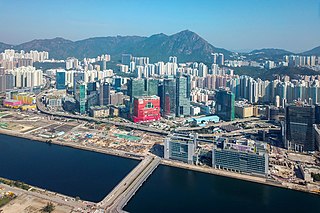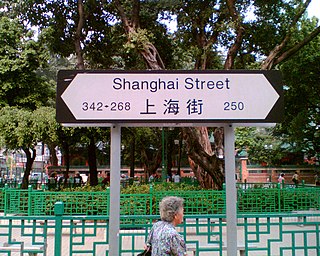
Sham Shui Po is an area of Kowloon, Hong Kong, situated in the northwestern part of the Kowloon Peninsula, north of Tai Kok Tsui, east of Cheung Sha Wan and south of Shek Kip Mei (石硤尾). It is located in and is the namesake of the Sham Shui Po District.

Kowloon Bay is a body of water within Victoria Harbour and an area within Kowloon, Hong Kong.

To Kwa Wan is a bay and an area of the eastern shore of Kowloon peninsula. The area is part of urban Hong Kong, and is situated between Hok Yuen, Hung Hom, Ma Tau Chung and Ma Tau Kok. Administratively, the area belongs to the Kowloon City District of Kowloon.

Sha Tin, also spelt Shatin, is a neighbourhood along Shing Mun River in the eastern New Territories, Hong Kong. Administratively, it is part of the Sha Tin District. Sha Tin is one of the neighbourhoods of the Sha Tin New Town project.

Austin is an underground MTR rapid transit station on the Tuen Ma line in Hong Kong, situated perpendicular to Wui Cheung Road and Austin Road West, and formerly adjacent to Jordan Road Ferry Pier Bus Terminus.

Shanghai Street is a 2.3 km long street in the Jordan, Yau Ma Tei and Mong Kok areas of Kowloon, Hong Kong, China. Completed in 1887 under the name of Station Street (差館街), it was once the most prosperous street in Kowloon. It originates from the south at Austin Road, and terminates in the north at Lai Chi Kok Road. Parallel to Shanghai Street are Nathan Road, Temple Street, Portland Street, Reclamation Street and Canton Road. Though parallel, Shanghai Street was marked by 2- to 3-floor Chinese-style buildings while Nathan Road was marked by Western-style buildings.

Ma Tau Kok is a place north of To Kwa Wan, south-east of modern-day Ma Tau Chung and south-west of the former Kai Tak Airport in Hong Kong. It was a cape in Kowloon Bay in Victoria Harbour and opposite to the Sacred Hill and the mouth of Ma Tau Chung. Ma Tau Kok is a mixed industrial and residential area.

The North Kowloon Magistracy is a historic building and former Magistrate's Court located at No. 292, Tai Po Road, Shek Kip Mei, Kowloon, Hong Kong.
The Revitalising Historic Buildings through Partnership Scheme is an initiative launched by the Hong Kong Government, part of a broader policy of heritage conservation in Hong Kong. In order to preserve and put historic buildings into good use and promote public participation in conserving historic buildings, the Hong Kong Government has chosen Government-owned buildings for adaptive reuse under the Scheme.

Hulu Culture is a Hong Kong based non-profit organisation established in 2009 that endeavors to protect Hong Kong traditional culture and heritage. Based in Kwai Chung Town in the New Territories, it is partly funded by the Hong Kong Jockey Club. In August 2013 the organisation also received a grant of $1,515,600 from the Government of Hong Kong for their "Energising Kowloon East: Sustainable Development of Made in Hong Kong Project".

The 13 Streets is an area in Ma Tau Kok, Kowloon City District, Hong Kong.

The Jockey Club Creative Arts Centre is a multi-disciplinary arts centre in Shek Kip Mei, Hong Kong, housed in a converted nine-storey factory estate.
Hong Kong Green Jazz Festival is an annual music festival held in Hong Kong, which incorporates local live jazz music. The first Festival took place on 30 December 2012, in the Cattle Depot Artist Village (牛棚藝術村). It was founded on 6 August 2012, and organized by "Original Sound", which aims to provide platforms for youngsters whose skills or psychological qualities may not be able to meet the international levels to share their music.

The former Lai Chi Kok Hospital, located at No.800 Castle Peak Road, Lai Chi Kok, Kowloon, was listed as one of the Grade III historic buildings in Hong Kong on 24 June 2010. The site has now been transformed into Jao Tsung-I Academy under batch 1 of the Hong Kong Government's revitalisation scheme.

Oi! is a Hong Kong government art promotion organisation. It was developed by the Leisure and Cultural Services Department, and aims to promote visual arts by providing a platform for art exhibitions, forums and other art-related activities. It is situated at 12 Oil Street, North Point, at the corner of Electric Road.

Ivy Ma is a Hong Kong visual artist specializing in mixed media works. Her works were featured in the Hong Kong Art Biennial in 2005 and the Hong Kong Contemporary Art Awards in 2012. She was the winner of the Young Artist Award category of the 2012 Hong Kong Contemporary Art Awards. She was one of the fifteen artists included in the online Artshare exhibition entitled Resistance dedicated to Hong Kong artists, curated by art writer Caroline Ha Thuc. Recipients of the FCO Chevening University of Leeds Scholarship from the Hong Kong Arts Development Council and the Lee Hysan Foundation Fellowship from the Asian Cultural Council, she participated in various artist-in-residence programs and international artist workshops in Bangladesh, Finland, Åland, and the USA from 2005 to 2009. Her works are in the collection of the Hong Kong Heritage Museum and is part of the Hong Kong Legislative Council Complex Art Acquisition Project commissioned by the Hong Kong Legislative Council Commission.
The visual art of Hong Kong, or Hong Kong art, refers to all forms of visual art in or associated with Hong Kong throughout its history and towards the present. The history of Hong Kong art is closely related to the broader history of Chinese art, alongside the art of Taiwan and Macau. Hong Kong art may include pottery and rock art from Hong Kong's prehistoric periods; calligraphy, Chinese ink painting, and pottery from its time under Imperial China; paintings from the New Ink Painting Movement and avant-garde art emerging during Hong Kong's colonial period; and the contemporary art practices in post-handover Hong Kong today.

Videotage is a Hong Kong-based non-profit art organisation dedicated to nurturing emerging media artists and the development of the local new media art community.
Oil Street Artist Village was an artist community occupying the former Government Supplies Department Headquarters (GSDH) at Oil Street, Fortress Hill, Hong Kong from 1998 to 2000. It has been described as Hong Kong's first artists colony.
Keith Lam is a Hong Kong new media artist. He is the co-founder and artistic director of Dimension Plus.





















